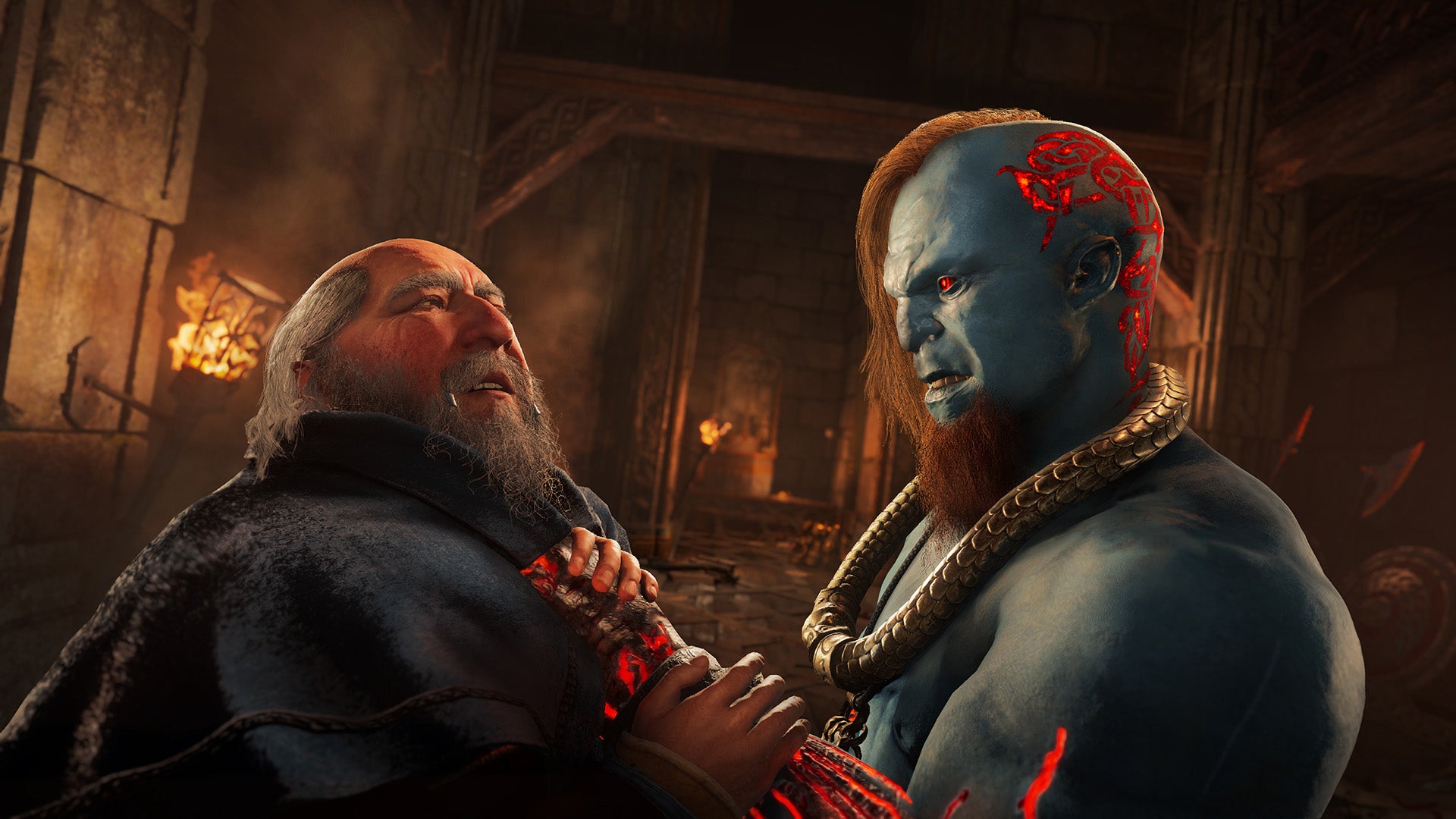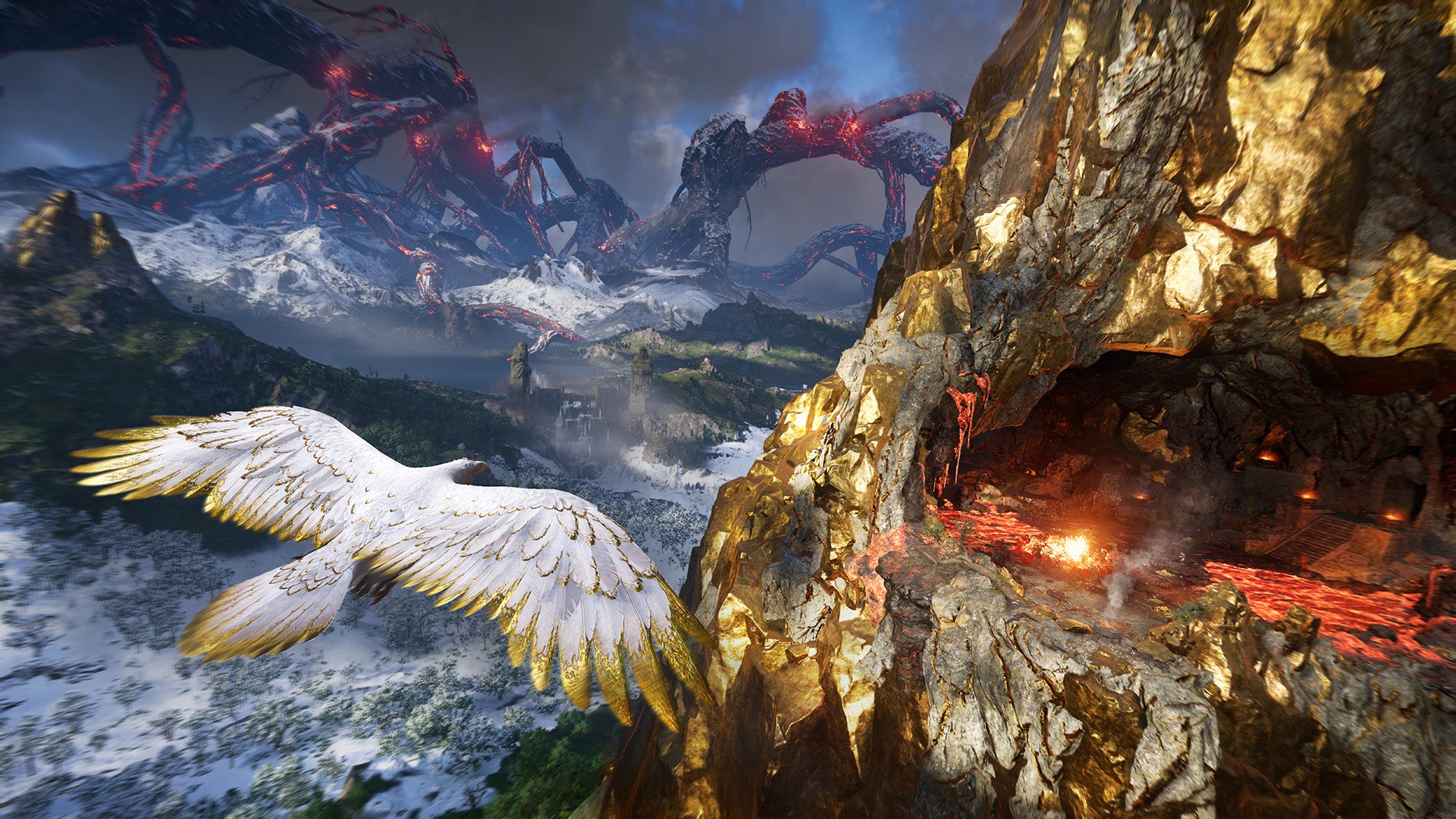Its most prominent project to date was Assassin’s Creed Rogue, the oft-overlooked ship-based sequel to Black Flag which remixed the series’ popular pirate entry in various ways. And there’s a similar feel here to Dawn of Ragnarök, which remixes Valhalla’s gameplay and adds a couple of fresh flavours to the mix. For the uninitiated, Dawn of Ragnarök is due in March as part of Valhalla’s second year of post-launch content, designed as a meaty mythological expansion weighing in at around 40 hours. As its name suggests, it focuses on the Odin part of Valhalla’s story and is set before the Viking god endgame (as for how that might relate to Valhalla… we’ll keep spoilers here to a minimum). Still, things are certainly cooking up a notch as the expansion kicks off, with the fiery realm of Muspelheim invading the peaceful dwarven home of Svartalfheim, which is where the expansion is set. (Expect a brief appearance from Viking Eivor to set things up and react to its revelations, but otherwise this is very much Odin’s story.) A 20-minute demo which Eurogamer saw last week showed how Dawn of Ragnarök rips free from some of Valhalla’s Viking shackles, and goes to town with powers more befitting a Norse god - all while keeping gameplay tactical. The expansion’s systems and gameplay revolve around a new two-power loadout system, with abilities scooped up from fallen enemies and swapped out at will as you tackle different situations. This system is called the Hugr-rip, as it literally pulls the abilities of foes from their bodies. (Hugr is used here as a rough equivalence for the Norse concept of a soul.) So, for example, there’s the Power of Muspelheim, which you can rip from fallen, fiery Muspel enemies. This makes Odin immune to lava and fire, and means he can also pass as a Muspel via social stealth, making it easy to get out of combat. (A very good thing, as Valhalla’s combat could often drag on.) The Power of the Raven, meanwhile, is acquired from giant birds. This lets Odin shapeshift into raven form and traverse Svartalfheim via air, then quickly land on any scalable surface. Each Hugr-rip power can be upgraded, and your raven ability can be buffed to include Raven Assassination. Sadly, this does not mean you can peck enemies to death. Instead, this lets you Air Assassinate enemies as Odin straight out of your flying state, albeit while also deactivating the power. We also saw The Power of Rebirth, taken from large enemies, which immediately reanimates fallen foes to your side for as long as your Hugr meter allows. This new gauge puts an effective time limit on your godly powers, but can be topped up from any living creature in the world, including certain plants, or from altars where Odin can sacrifice health for a Hugr fix. There’s also a tactical side to all of this, too: in picking the powers you want for a particular situation, or for your particular playstyle, and then keeping your Hugr topped up by correctly timing and chaining kills and the use of your abilities. “I like to play stealthily and remain hidden,” Ragnarök creative director Mikahil Lozanov, a 15-year-veteran of Ubisoft Sofia, tells me. “So most of the time I play with the raven power which lets me quickly escape or infiltrate, together with the powers of Muspelheim or Jotunheim which allow me to blend socially.” As our demo begins, Odin is looking for aid in an underground dwarven shelter, a deep cave in a mountain filled with luminous green crystals. We’re in Svartalfheim because Odin’s son Baldr has been kidnapped by Muspel boss Surtur, who is also knocking about somewhere, though Odin is currently busying himself helping out the locals. I enjoyed some of the dialogue here, as Odin clearly has a history with these people, even if it’s our first stop in the realm within Valhalla. While in the shelter, we can also stop by a dwarven blacksmith to upgrade Odin’s Hugr-rip gadget, the thing which enables our new suite of powers. Gameplay wise, while very pretty, this is so far, so much Valhalla. But as we exit the cave Lozanov flexes some of the expansion’s muscle - transforming into a raven to investigate a nearby dwarven town taken over by Muspel forces. In a flourish, we’ve dropped down, transforming back into Odin just above a Muspel leader and immediately assassinated him, before launching into combat using the new atgeir polearm weapon which provides a fresh set of new aera of attack finishers. The Muspel are just one faction of enemies in Svartalfheim (the Jotuns are here too, as well as other mythical beasts) and combat with them is a chunky affair - lava dribbling out of their chests as you hack away. Quickly, using the Power of Rebirth, we see Odin conjure up every enemy he’s just felled to take forward into the next fight on his side, accompanied by a molten mini-army. A little later, Odin homes in on the person he’s tracking. We venture through a lava-filled cave but our exploration is limited here as we don’t have the Power of Muspelheim active. Lozanov says this is part of the idea behind the powers, which are meant to expand the game beyond combat, and provide choice on how to tackle certain areas. For those who’ve completed Valhalla’s story, Ragnarök will expand on Odin’s story reveals (and it’s set after the Jotunheim arc). For those who haven’t, it is playable without any prior knowledge of the game, though Lozanov tells me there will be plenty of extra layers here for those who are up to date on the game - and other games in the franchise. (So yes, for those who seek it out, expect more Isu lore.) Outside of the main Ragnarök campaign, there’s a Valkyrie Arena, with Boast modifiers you can stack for tougher fights. And, of course, there’s your typical, beautiful world to poke around in, with plenty of bits and pieces to find if you venture off the beaten track. Ragnarök doesn’t present itself as a reinvention of Valhalla, but there’s enough here that when I finally play it myself, I’m keen to see if it feels new enough. Ubisoft Sofia did it with Rogue, and looks set to do it again here.



